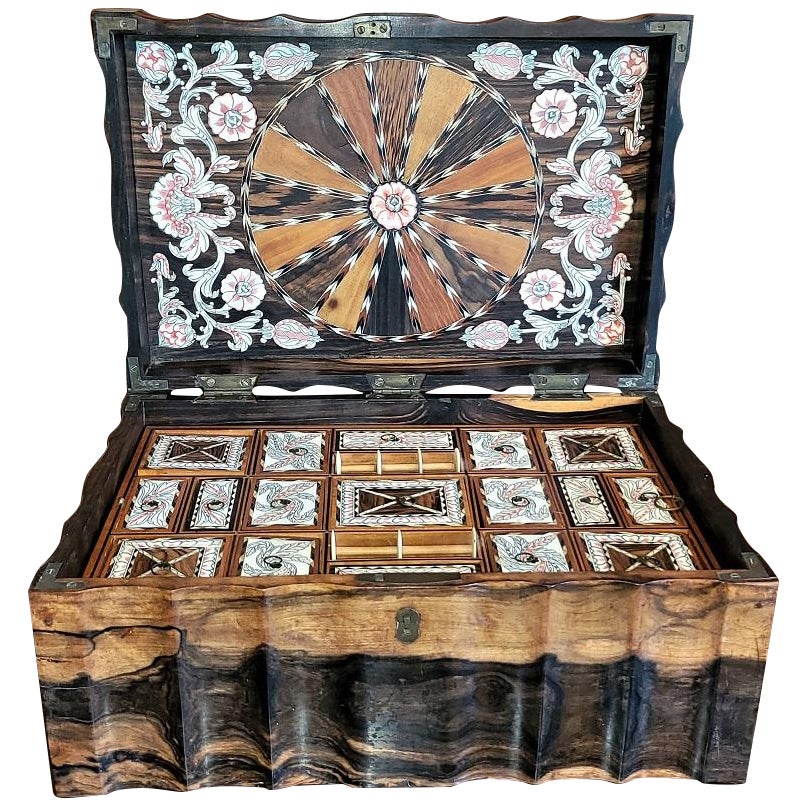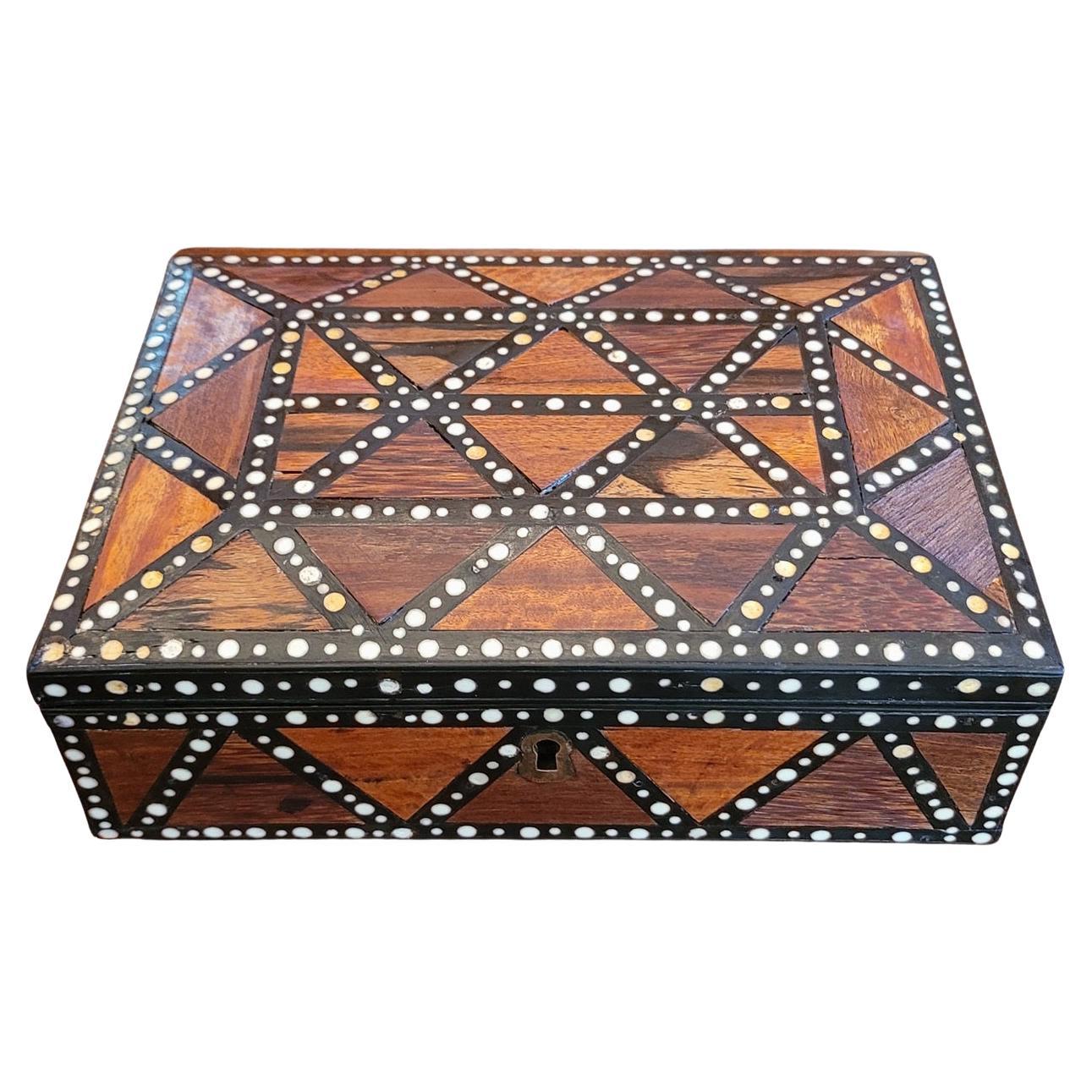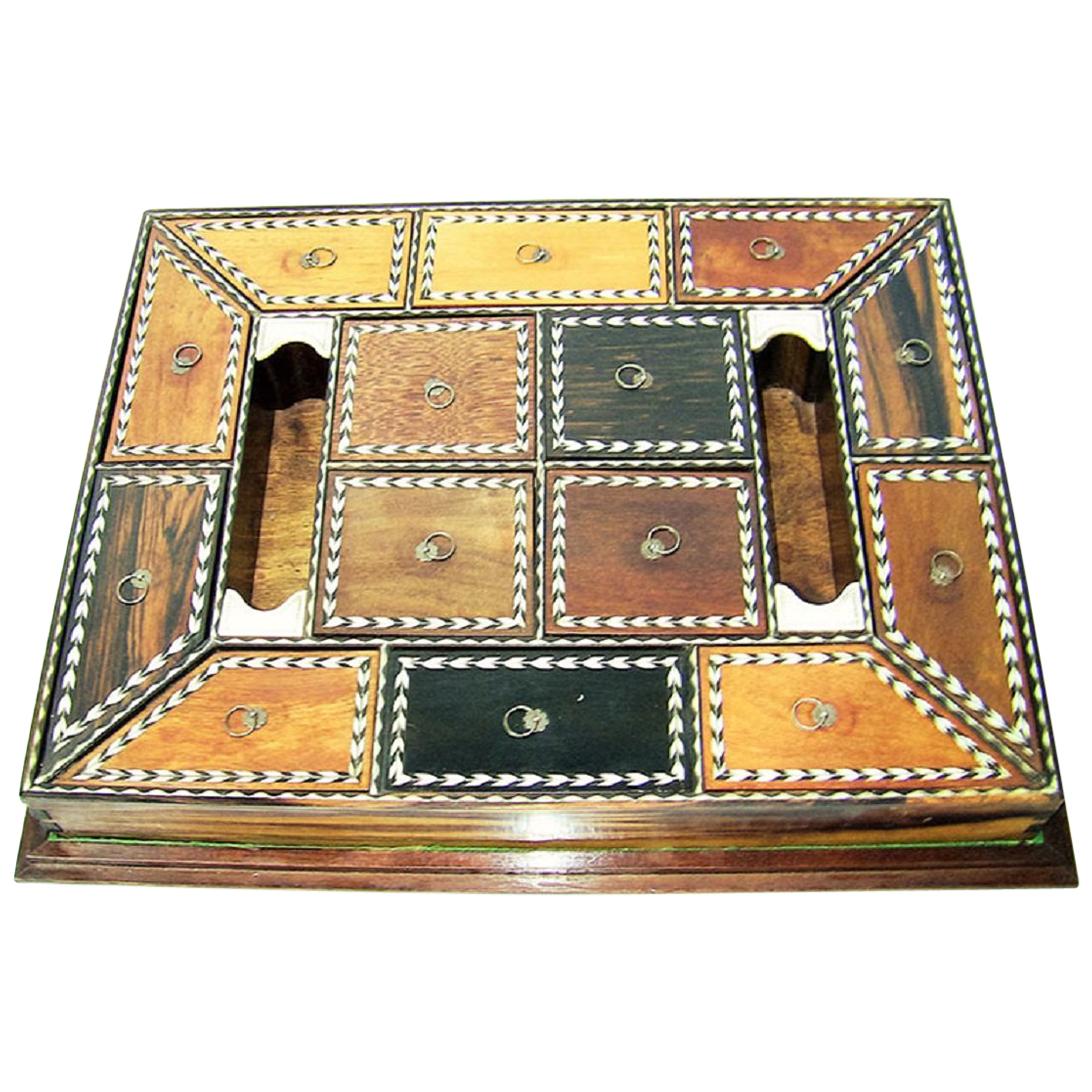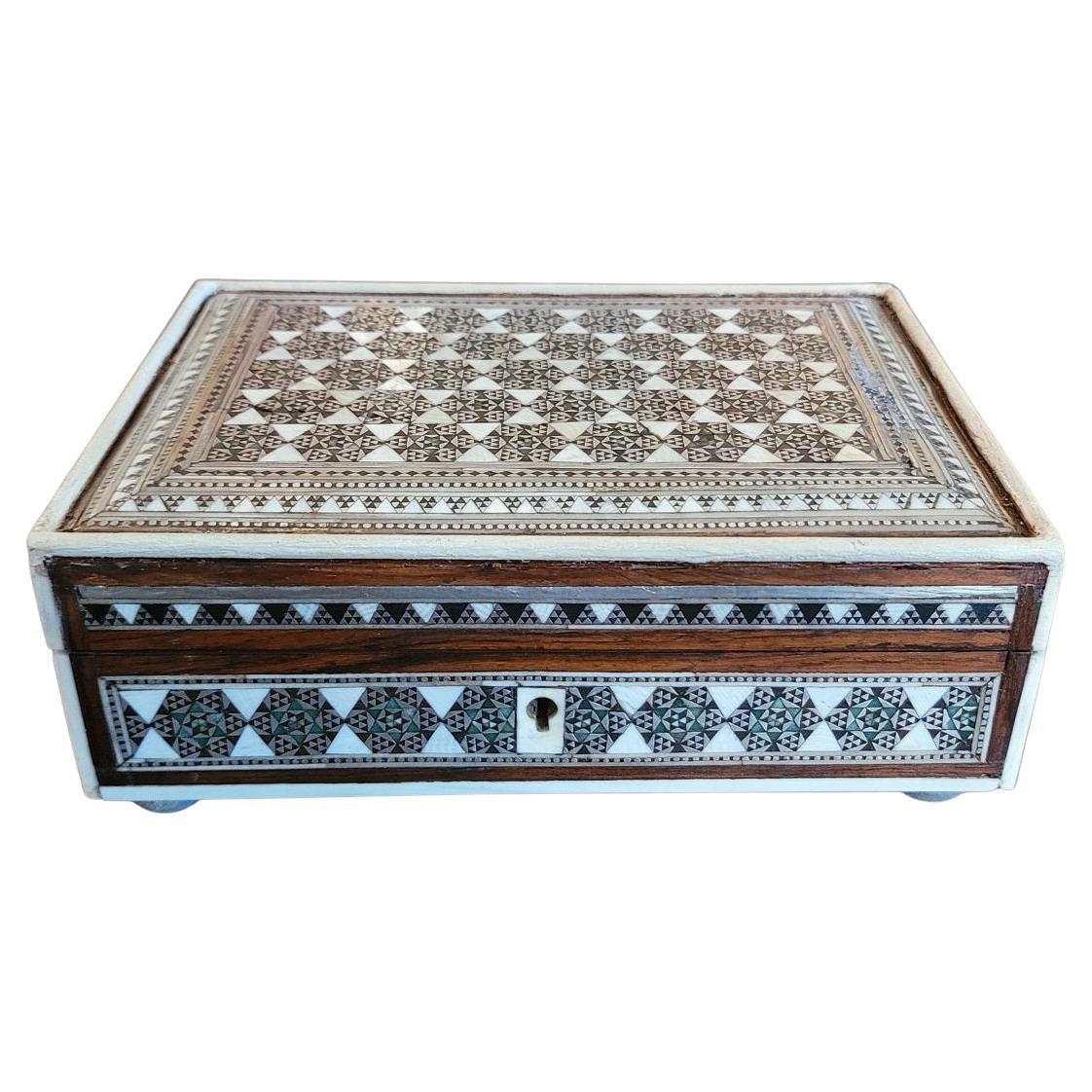Items Similar to 19C Anglo Ceylonese Lap Desk of Museum Quality
Want more images or videos?
Request additional images or videos from the seller
1 of 21
19C Anglo Ceylonese Lap Desk of Museum Quality
About the Item
Presenting an absolutely fantastic 19C Anglo Ceylonese lap desk of museum quality.
We can safely say that this is one of the finest lap desks we have ever seen !
The Lap desk box is rectangular in shape when fully closed, with the most gorgeous reeding design of the wood all over. This ‘reeding’ in itself makes this box a VERY VERY RARE example.
The ‘box’ was appraised by the prestigious Rothchilds Antiques of NOLA in 1978 and given a value of $1,000 in 1978. Allowing for inflation alone this equates to over $4,200 in today’s value. As experts in Anglo-Indian and Anglo-Ceylonese items we are going to slightly disagree with Rothchilds on one issue: – We do not believe that this box is made from Jacaranda Wood. We believe it to be ebony and coromandel woods. The secondary wood is sandalwood.
Not only is they style and construction of the outer box very unusual and rare but the interior once opened is OUTSTANDING !
The box opens to reveal a writing slope with blue leather insert. Both the top section of the writing slope and the larger bottom section have a lift up lid to reveal a storage area underneath. The larger area is also lined with matching blue leather.
Above the writing slope is a sectioned area for holding writing accessories like inkwells, pens etc. The pend holding lid which is heavily decorated and inlaid with bone, lifts to reveal more space underneath. In the front section is have a highly decorated and inlaid with bone, tubular baton and a simple ebony tubular pointer. We have never seen this before !
The top section is a sliding section, that slides upwards on a pair of brass plates on each side, when fully open to reveal a STUNNING bureau area with 3 doors, 2 drawers and to 2 cubbies. Each is heavily decorated with bone, pewter or silver, inlaid specimen exotic hardwoods and hand painted chevron and floral decorations. The hardwood inlays in triangular sections replicate the look of tortoiseshell.
This section slides downwards to close the box.
This box would have been made in Ceylon (now Sri Lanka) during British occupation and control and would have been made specifically for the British market. It is a form of ‘campaign’ piece and would have been made for a very high ranking British Army Officer. It would have been a VERY EXPENSIVE PIECE WHEN MADE !!!
IT IS A MUSEUM QUALITY PIECE !
In super original condition, with only very minor blemishes through age and use. No key.
Dimensions: Closed the Box is 16.9 inches Wide, 10 inches Deep and 5.25 inches High
Fully Open the box is 8 inches High, 16.9 inches Wide and 16.5 inches Deep
ANGLO-INDIAN AND CEYLONESE BOXES: Anglo Indian boxes were made in India for the English residents from the early part of the 18th century. They were brought back or sent back to England usually by the people who had commissioned them. From the beginning of the nineteenth century they were imported more commercially, although not in any significant numbers until the middle decades. They were very highly valued, especially the early ones, to the extent that the designs were copied on late 19th and early 20th century tins.
Anglo-indian Boxes normally consist of 3 main types:-
(1) Most of the best and highest quality Anglo-Indian boxes in the 18th and 19th Centuries were made in Vizagapatam, India, renowned for its exquisite craftsmanship in using ivory and tortoiseshell and lac decoration. These are referred to as ‘Vizagapatam Boxes’.
(2) The Bombay area became famous in the 19th Century for its carving of sandalwood boxes and use of Sadeli Mosaic. These are often referred to ‘Sadeli Boxes’.
(3) Many boxes of exquisite quality and craftsmanship were made in Ceylon (modern day Sri Lanka) in the 19th Century. Ceylon was part of the British Indian Colony and was not a seperate Country at that time, hence, the boxes that were made in Ceylon are often categorized as Anglo-Indian. Many of the Anglo-Ceylonese pieces were made in the Goa Region using Porcupine Quill, Coromandel or Salamander wood, ivory, ebony and lac decoration. The Ceylonese lac work was often more colorful than the Vizagapatam classic use of black lac ink.(Lac ink was an indelible ink made from crushing Lac Beetles). Ceylonese boxes and furniture also became famous, due to the use of various exotic specimen woods in the decoration of their boxes and furniture. These specimen wood pieces are HIGHLY PRIZED AND HIGHLY DESIRABLE !!
This box falls into Category 3 above ………………….. SPECTACULAR AND RARE !!
- Dimensions:Height: 5.25 in (13.34 cm)Width: 16.9 in (42.93 cm)Depth: 10 in (25.4 cm)
- Style:Anglo-Indian (Of the Period)
- Materials and Techniques:
- Place of Origin:
- Period:
- Date of Manufacture:1810-1820
- Condition:Wear consistent with age and use.
- Seller Location:Dallas, TX
- Reference Number:1stDibs: LU3978125873512
About the Seller
4.9
Platinum Seller
These expertly vetted sellers are 1stDibs' most experienced sellers and are rated highest by our customers.
Established in 2015
1stDibs seller since 2018
349 sales on 1stDibs
Typical response time: <1 hour
- ShippingRetrieving quote...Ships From: Dallas, TX
- Return PolicyA return for this item may be initiated within 7 days of delivery.
More From This SellerView All
- 19C Anglo Ceylonese Sewing Box of Museum QualityLocated in Dallas, TXPresenting an absolutely stunning 19c Anglo Ceylonese sewing box of museum quality. Made in Ceylon (now Sri Lanka) circa 1860, this is one of the finest sewing boxes of it’s kind that we have ever seen! The box is made from coromandel wood (an exotic hardwood found in Ceylon) and has a serpentine edging all over the front, back and sides. Very often the lids/tops of these boxes suffer cracks due to shrinkage but this one is near perfect with no crack in the lid/top. There is some evidence of natural shrinkage but that is around the edges of the lid/top. It is when you open this box that it reveals it’s true beauty, quality and treasure ! The inside of the lid/top is heavily and beautifully decorated with inlaid bone in scrolling floral patterns which have then been hand painted with red and black ‘lac’ ink. The central medallion is a circle of inlaid specimen exotic hardwoods radiating towards a central bone and hand painted flower. The circle is edged in bone, wood and silver chevrons. What makes this box Exceptionally rare is that it contains 3 lift out base sections. Normally, there would be a maximum of 2. The first tray/section is clearly for the purposes ancillary to sewing with a pair of sections with bone spools for thread etc. There are 17 other lidded compartments with each one highly decorated using hand painted bone and specimen woods to replicate tortoiseshell. The first tray lifts out to reveal a second removeable tray which is made up of a pair of open sections and 8 specimen wood lidded sections each with chevron banding. The third tray is a smaller tray underneath with 14 lidded compartments each with hand painted bone and specimen wood inlaid lids again, replicating the look of tortoiseshell. Again they are banded with a chevron border. This is a museum quality piece ! It is in fantastic condition for it’s age with the minor shrinkage to the edges of the lid/top, some finger pulls missing and some very minor cracks to the tray lids and bases but nothing that in any way detracts from the piece. No key. Dimensions: Closed the box is 16.75 inches wide, 11.25 inches deep and 7.5 inches high Fully open the box is 16.5 inches high, 16.75 inches wide and 11.4 inches deep Anglo-Indian and ceylonese boxes: Anglo Indian boxes were made in India for the English residents from the early part of the 18th century. They were brought back or sent back to England usually by the people who had commissioned them. From the beginning of the nineteenth century they were imported more commercially, although not in any significant numbers until the middle decades. They were very highly valued, especially the early ones, to the extent that the designs were copied on late 19th and early 20th century tins. Anglo-Indian boxes normally consist of 3 main types:- (1) Most of the best and highest quality Anglo-Indian boxes in the 18th and 19th centuries were made in Vizagapatam, India, renowned for its exquisite craftsmanship in using ivory and tortoiseshell and lac decoration. These are referred to as ‘Vizagapatam Boxes...Category
Antique Mid-19th Century Sri Lankan Anglo-Indian Decorative Boxes
MaterialsSilver
- 19C Anglo Ceylonese Specimen Wood Trinket BoxLocated in Dallas, TXPRESENTING A BEAUTIFUL and RARE 19C Anglo Ceylonese Specimen Wood Trinket Box. Made in ‘Galle’, Ceylon (now Sri Lanka) circa 1860-80. Made for the ex...Category
Antique 19th Century Sri Lankan Anglo-Indian Jewelry Boxes
MaterialsBone, Hardwood, Ebony, Sandalwood
- 19C Anglo Indian Vizigapatam Stamp BoxLocated in Dallas, TXPresenting an absolutely gorgeous and very rare 19C Anglo Indian Vizigapatam stamp box. Made in Colonial India (the Time of the Raj) circa 1860. Prob...Category
Antique Mid-19th Century Indian Anglo-Indian Decorative Boxes
MaterialsBone, Shell
- 19th Century Anglo Ceylonese Specimen Wood Desk Companion TrayLocated in Dallas, TXAnother stunning 19th century Anglo-Ceylonese piece. Made circa 1880 in Ceylon (Now Sri Lanka) of Coromandel wood and specimen woods. This is a simply gorgeous and quality item!! Tray made of various compartments with various high quality specimen wood lids, all edged and banded in chevrons of bone, silver or pewter and ebony. The tray itself is made of expensive coromandel wood. There are two open sections on either side of the tray which have bone and hand-painted lac ends. The main tray sits onto a base made of coromandel wood with green baize lining. This tray could have a number of practical uses, for keeping stationary, watches, jewelry, or thinking outside of the box, holding you remote controls and candy!! We have a matching box also in our Inventory and for auction. ANGLO-INDIAN AND CEYLONESE BOXES: Anglo Indian boxes were made in India for the English residents from the early part of the 18th century. They were brought back or sent back to England usually by the people who had commissioned them. From the beginning of the nineteenth century they were imported more commercially, although not in any significant numbers until the middle decades. They were very highly valued, especially the early ones, to the extent that the designs were copied on late 19th and early 20th century tins. Anglo-indian Boxes normally consist of 3 main types:- (1) Most of the best and highest quality Anglo-Indian boxes in the 18th and 19th Centuries were made in Vizagapatam, India, renowned for its exquisite craftsmanship in using ivory and tortoiseshell and lac decoration. These are referred to as ‘Vizagapatam Boxes...Category
Antique Late 19th Century Sri Lankan British Colonial Decorative Boxes
MaterialsEbony, Wood
- 19C Anglo Indian Sadeli Mosaic Greeting Card CaseLocated in Dallas, TXPresenting a superb 19C Anglo Indian Sadeli Mosaic greeting card case. Made in or around Bombay, India circa 1880. This is a greeting card case used for holding your greeting cards or business cards of the day ! The body of the case is made from sandalwood and it is fully overlaid with bone and highly intricate Sadeli Mosaic made up of thousands of micro mosaic pieces of bone, ebony, silver/pewter and semi precious stone. The workmanship is stupenduous !!!! This case is almost museum quality. One or two very, very minor losses of mosaic mainly where the top meets the body but otherwise near mint ! SADELI MOSAIC: “Anglo Indian boxes were made in India for the English residents from the early part of the 18th century. They were brought back or sent back to England usually by the people who had commissioned them. From the beginning of the nineteenth century they were imported more commercially, although not in any significant numbers until the middle decades. They were very highly valued, especially the early ones, to the extent that the designs were copied on late 19th and early 20th century tins. The ancient art of Sadeli Mosaic is said to have been introduced from Shiraz in Persia via Sind to Bombay, a long time before the Anglo Indian boxes were made. It was a technique, which required a high degree of skill and patience. It was executed very lavishly, in that the frequent cuts wasted a great amount of the precious materials used. The workmanship was however more than commensurable to the value of the materials. Ivory, silver, pewter (or other metals), wood and horn were cut into faceted rods which were bound together to form geometric patterns. When the glue has set, the rods were sliced in transverse sections. This gave the maker a number of angled circular pieces in the original pattern. Several variations of patterns could be achieved by combining the materials in different ways. The ivory was sometimes dyed green to give an extra color. The mosaic pieces in a combination of patterns, often separated by ivory, ebony, horn or silver stringing were used to veneer sandalwood boxes. In the early boxes, which date from the turn of the 18th to the 19th century, there are large panels of mosaic covering tops and sides of boxes. It took incredible skill to cover such large areas without any shakes or wavering of the pattern. The corners and joins on these boxes are impeccably matched. The makers (reputed to be Persian) of Sadeli mosaic made in the first two decades of the 19th century displayed a total understanding of the qualities of the different materials they used. They combined substances, which can expand and contract according to atmospheric conditions with others, which are hard and unyielding. The result was a sharp definition of the lines and patterns, which made up the whole design. On the early boxes the designs look deceptively simple. The fact is, they emerged from a culture, which had mastered geometry and understood how to generate a pattern from a set number of points. The patterns are so harmoniously combined that their incredible complexity is not immediately apparent. The earliest Sadeli boxes...Category
Antique Late 19th Century Indian Anglo Raj Decorative Boxes
MaterialsBone, Precious Stone, Ebony
- 19C Anglo Indian Bombay MOP Sadeli Mosaic Trinket BoxLocated in Dallas, TXPRESENTING a LOVELY 19C Anglo Indian Bombay MOP (Mother of Pearl) Sadeli Mosaic Trinket Box from circa 1875-85. Gorgeously detailed and hand-crafted ‘sadeli mosaic’ inlay, from the Bombay Area, with deep greens with silver, pewter, mother of pearl, bone and ebony in geometric patterns. The box case, is made of sandalwood but completely covered in MOP, bone, faux ivory, ebony and mosaic inlay. Edged with faux ivory and banded with a different pattern of sadeli mosaic. Some minor damage to the top (repair is obvious in pics) and ivorine replacements to some edging, but it still a BEAUTIFUL BOX and of real QUALITY! The mosaic work is FABULOUS! Box opens to reveal its original blue velvet lining. It sits on 4 (recently added) silvered button feet. SADELI MOSAIC: “Anglo Indian boxes were made in India for the English residents from the early part of the 18th century. They were brought back or sent back to England usually by the people who had commissioned them. From the beginning of the nineteenth century they were imported more commercially, although not in any significant numbers until the middle decades. They were very highly valued, especially the early ones, to the extent that the designs were copied on late 19th and early 20th century tins. The ancient art of Sadeli Mosaic is said to have been introduced from Shiraz in Persia via Sind to Bombay, a long time before the Anglo Indian boxes were made. It was a technique, which required a high degree of skill and patience. It was executed very lavishly, in that the frequent cuts wasted a great amount of the precious materials used. The workmanship was however more than commensurable to the value of the materials. Ivory, silver, pewter (or other metals), wood and horn were cut into faceted rods which were bound together to form geometric patterns. When the glue has set, the rods were sliced in transverse sections. This gave the maker a number of angled circular pieces in the original pattern. Several variations of patterns could be achieved by combining the materials in different ways. The ivory was sometimes dyed green to give an extra color. The mosaic pieces in a combination of patterns, often separated by ivory, ebony, horn or silver stringing were used to veneer sandalwood boxes. In the early boxes, which date from the turn of the 18th to the 19th century, there are large panels of mosaic covering tops and sides of boxes. It took incredible skill to cover such large areas without any shakes or wavering of the pattern. The corners and joins on these boxes are impeccably matched. The makers (reputed to be Persian) of Sadeli mosaic made in the first two decades of the 19th century displayed a total understanding of the qualities of the different materials they used. They combined substances, which can expand and contract according to atmospheric conditions with others, which are hard and unyielding. The result was a sharp definition of the lines and patterns, which made up the whole design. On the early boxes the designs look deceptively simple. The fact is, they emerged from a culture, which had mastered geometry and understood how to generate a pattern from a set number of points. The patterns are so harmoniously combined that their incredible complexity is not immediately apparent. The earliest Sadeli boxes...Category
Antique Late 19th Century Indian Anglo-Indian Jewelry Boxes
MaterialsSilver
You May Also Like
- 19th Century Anglo Ceylonese Porcupine Quill Box with Interior Divided TrayLocated in Chapel Hill, NCA large rectangular box made of dark hardwood inlaid with bone dots framing panels of porcupine quill. The exterior of the box is veneered with quill cut and arranged to create a zig...Category
Antique Late 19th Century Sri Lankan Anglo Raj Decorative Boxes
MaterialsBone, Wood
- 19Thc Walnut Desk Top Lap DeskLocated in Los Angeles, CA19Thc Walnut desk top lap desk with a dovetailed case and wonderful aged patina.The condition is very good with a bone keyhole.Category
Antique 1860s American Adirondack Jewelry Boxes
MaterialsWood
- English Lap DeskLocated in Stamford, CTBeautiful Early 19th century rosewood lap desk. Made in England, circa 1830. Has brass corners and brown leather writing surface with gold tooling. Left side...Category
Antique Early 19th Century English Inkwells
MaterialsRosewood
- 19th Century European Inlaid Decorative Lap Desk BoxLocated in Richmond, VAOffered is an exquisite, 19th Century European lap desk box with abalone and wood inlay. Brass escutcheon and felt velvet lining. Does not include original key.Category
Antique 19th Century French French Provincial Decorative Boxes
MaterialsBrass
- Mid-19th Century Campaign Camphor Metamorphic Lap DeskLocated in Debenham, SuffolkRare and good quality camphor wood writing desk, circa 1860. Brass bound around the outer edges and carrying handles to each side. These desk were made for sea captains and office...Category
Antique Mid-19th Century Indonesian Campaign Decorative Boxes
MaterialsHardwood
- 19th Century Anglo-Indian Sadeli Inlaid Work Box Traveling Writing DeskLocated in Stamford, CTA stunning camel bone, ebony and metal inlaid sadeli work box with portable writing desk, Bombay, circa 1850. The sandalwood body of faceted rec...Category
Antique Mid-19th Century Indian Anglo-Indian Decorative Boxes
MaterialsMetal
Recently Viewed
View AllMore Ways To Browse
Antique Museum
Pair Of Desks
Museum Quality Antique Furniture
19c Furniture
Heavy Desk
Antique Museum Quality
Imports Of India
Large Black Desk
Large Desk Black
Antique Desk Decorations
Famous Desk
Antique Look Desk
Antique Looking Desk
Antique Look Desks
Typing Desk
All In 1 Desk
English Made Desk
Antique Looking Office Desk





